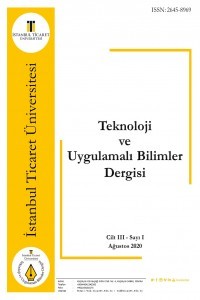TOPLU TAŞIMA HİZMETLERİNDEKİ ÜCRETLENDİRME SİSTEMLERİ DEĞERLENDİRİLEREK, İSTANBUL İÇİN EN UYGUN OLANIN SEÇİLMESİ
Toplu taşıma ücretlendirme politikası, ulaşım talebi açısından hem toplu taşıma hem de özel araç kullanıcılarını doğrudan etkileyen bir sistemdir. Farklı fiyat politikaları yardımıyla yolculukların mevcut toplu taşıma altyapısına uygun olması sağlanacaktır. Toplu taşıma hizmetlerinde sabit ve değişken fiyat uygulaması olarak iki farklı ücretlendirme sisteminin kullanıldığı görülmektedir. Sabit ücret sistemi, tüm toplu taşıma araçlarında tek bir fiyatın uygulandığı yöntemdir. Değişken ücret sistemi ise, bilet fiyatlarının zaman, mesafe, bölge, hizmet ve kullanıcı türleri gibi farklı parametrelere bağlı olarak uygulanmasından ibarettir. Bu çalışmada, herhangi bir kentteki toplu taşıma sistemiyle ilgili ücret politikası belirlenirken dikkat edilmesi gereken konular, tüm ücret politikaları ve her birinin amacı, avantaj ve dezavantajları incelenmiştir. Ayrıca kentin coğrafik ve demografik yapısı gibi özellikleri göz önünde tutularak uyumlu ücret politikasının seçilmesi babında kapsamlı araştırmalar yapılmıştır. Çalışmanın devamında, İstanbul’un kentsel özelliklerinin hangi ücretlendirme politikasına daha fazla uyum sağladığı irdelenmiştir. Sonuç olarak İstanbul için toplu taşıma kullanımı ücreti konusunda öneriler verilmiştir
Anahtar Kelimeler:
Toplu taşıma ücretlendirme politikaları, sosyal adalet, Sabit ücret, değişken ücret
Evaluation of Pricing Systems in Public Transport Services and Slection of The Most Suitable for Istanbul
Public transport pricing policy is a system that directly affects both public transport and private vehicle users in terms of transportation demand. With the help of different price policies, it will be ensured that the journeys are compatible with the existing public transport infrastructure. There are two different pricing systems as fixed and variable price applications in public transportation services. The flat fare system is the method by which a single price applies to all public transport. The differential fare system consists of applying public transport prices based on different parameters such as time, distance, region, and service types. In this study, the issues to be considered while determining the pricing policy related to public transportation system in any city, all pricing policies and the purpose, advantages and disadvantages of each are examined. In addition, considering the characteristics of the city such as geographic and demographic structure, comprehensive research has been carried out on the selection of a harmonious pricing policy. Then, considering the urban characteristics of Istanbul, which pricing policy is more appropriate is examined. As a result, suggestions have been made for Istanbul public transportation pricing policy.
___
- Benk, S., & Akdemir, T. (2010). Toplu Taşıma Hizmetlerinde Fiyatlama Stratejileri; Teorik Bir Değerlendirme. Ekonomi Bilimleri Dergisi, 2(1).
- Cats, O., & Susilo, Y. O. (2014). Public Transport Pricing Policy – Empirical Evidence from a 1 Fare-Free Scheme in Tallinn, Estonia. Transportation Research Board.
- Cervero, R. (1981). Flat Versus Differentiated Transıt Pricing: What's A Fmr Fare? Transportation 10, 211-232.
- Eriksson, L., Garvill, J., & Nordlund, A. M. (2006). Acceptability of travel demand management measures: The importance of problem awareness, personal norm, freedom, and fairness. Journal of Environmental Psychology, 15–26.
- Hamilton, C. J. (2012). Decisive factors for the acceptability of congestion pricing. Stockholm: Centre for Transport Studies.
- Huang, D., Liu, Z., & Cheng, J. (2015). The Analysis and Evaluation of Differentiated Transit Fare Structures. Applied Mechanics and Materials.
- Mark, S., & Phil, C. P. (2006 ). Developments in transit fare policy reform. presentation at 29th Australasian Transport Research Forum, Gold Coast Queensland, 27-29 September.
- Mohring, H. (1971). Optımızatıon And Scale Economıes In Urban Bus Transportatıon. Center for Economic Research.
- Nash, C., Sansom, T., & Still, B. (2001). Modifying transport prices to internalise externalities: evidence from European case studies. Regional Science and Urban Economics, s. 413–431.
- Transit Cooperative Research Program, TCRP Report 10. (1996). Fare Policies, Structures, and Technologies. Transportation Research Board.
- Transit Cooperative Research Program, TCRP Report 10. (2003). Fare Policies, Structures and Technologies: Update. Transportation Research Board.
- Tsai, F. M., Chien, S. I.-J., & Spasovic, L. N. (2008 ). Optimizing Distance-Based Fares and Headway of an Intercity Transportation System with Elastic Demand and Trip Length Differentiation. Transportation Research Record: Journal of the Transportation Research Board.
- Yayın Aralığı: Yılda 2 Sayı
- Başlangıç: 2018
- Yayıncı: İstanbul Ticaret Üniversitesi
Sayıdaki Diğer Makaleler
TÜRKİYE’DEKİ YARI DEĞERLİ TAŞLARIN SATIŞ STRATEJİLERİNİN GELİŞTİRİLMESİ
Mehmet Resul TOKA, Haluk SELİM
LASTİK TEKERLEKLİ ULAŞIMDA PERFORMANSA DAYALI HAKEDİŞ MODELİ
Ömer KARAKAYA, Mustafa ILICALI
SİNYALİZE KAVŞAKLARDA SÜRÜCÜ DAVRANIŞLARININ GECİKME SÜRESİNE ETKİSİ
Erdal DEMİRKAN, Mustafa ILICALI
Fatih KARAMAN, Mustafa ILICALI
TÜRKİYE’DE SAKİN ŞEHİR HAREKETİNE ÜYELİK SÜRECİ VE ÜYELİĞİN ETKİLERİ
